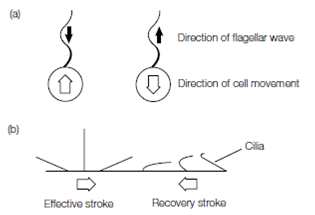Excavata
The Excavata supergroup contains the Euglenozoa within which are the flagellate forms the euglenids, the kinetoplastids, and a newly erected phylum the Fornicata, which contains some recently reclassified members of the diplomonads and trichomonads, previously considered to be basal members of the eukaryotic tree. Mitochondria are discoid throughout the group. There are two other unique features in the excavates the kinetoplast, a very structured inclusion of DNA in the mitochondrion, and the euglenid pellicle, a series of interlocking protein strips beneath the cell membrane.
Euglenids (from the phylum Euglenozoa) are unicellular, motile organisms, with two flagella that originate from a pocket at the anterior end of the cell. They may have a heterotrophic or photosynthetic nutrition. When photosynthetic, they contain chloroplasts with chlorophylls a and b and they store paramylon starch. These features suggest that the chloroplasts in this group originated from a chlorophytan ancestor. They inhabit nutrient-rich (eutrophicated) fresh and brackish water. Many species are capable of phagotrophy, and some are wholly saprophytic and devoid of chloroplasts. A few species are parasitic. They have a proteinaceous flexible pellicle that lies underneath the cell membrane very like that of the closely related alveolate species. The flexibility of this pellicle allows euglenids a characteristic flexibility termed euglenoid movement when

Figure Motility in (a) flagellates and (b) ciliates.
cells are on solid substrates. The pellicle allows the organism to move through muds and sands. The structure of the pellicle varies depending on the mode of nutrition; bacteria- eating phagotrophic species have small rigid cells with around 12 strips in the pellicle, while the eukaryote-eating species are bigger and have 20–60 helical strips. In some of the parasitic species the pellicle strips are fused into a single structure. The nuclei appear to contain many chromosomes, and polyploidy is common.
Kinetoplastids, the sister group to the Euglenozoa, are parasitic flagellates with a single large mitochondrion and a proteinaceous pellicle. They share many of the characteristics with the euglenids. The group is named after a large structure within the mitochondria called the kinetoplast, which contains DNA and associated proteins. The DNA is in the form of maxicircles and minicircles. As well as other proteins, maxicircles encode oxidative metabolism enzymes and minicircles encode unusual RNA-editing enzymes. Within this group are a number of human pathogens including trypanosomes T. brucei gambiense, T. brucei rhodesiense (spread by tsetse flies), and T. cruzi (transmit- ted by the bite of a triatomid bug), and the leishmaniasis pathogens, Leishmania tropica, L. major, and L. donovani, which are spread by sand flies.
Fornicata is a very recently devised clade that contains what were previously thought to be basal amitochondrial eukaryotes, the diplomonads and related species, but the recognition of a mitochondrion-like structure, the mitosome, and recent sequencing data place them within the Excavates. They have axially symmetric cell structures and the most notable member of the group is Giardia intestinalis, a human intestinal parasite. Parasite cysts are ingested in contaminated food and water, and germinate to form trophozoites, which stick to the intestinal epithelium and cause inflammation, cramps, and nonbloody diarrhea.